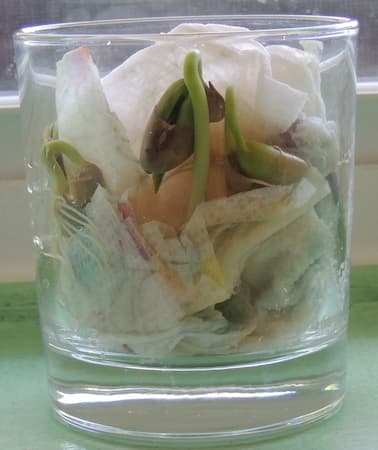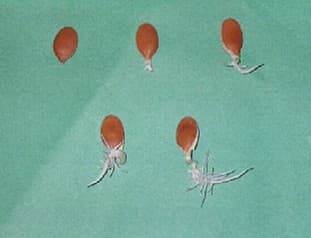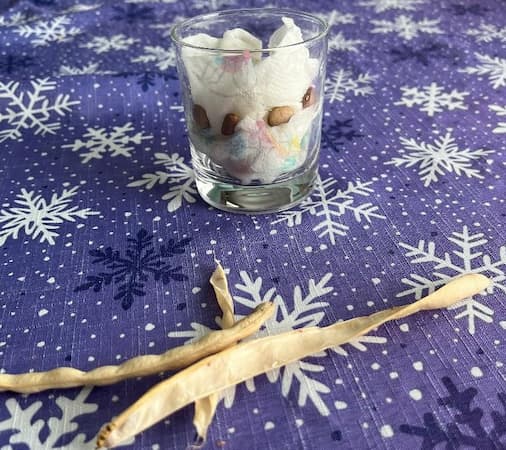Seed Germination Test

Perform a Seed Germination Test to Assure Seeds Will Sprout
You saved seeds from your garden plants to grow next year. That’s great! However, you want to be absolutely certain the seeds will sprout when you plant them next spring. A seed germination test will give you confidence that the seeds are viable and will sprout when you plant them.
it is important to know, that they will sprout in the spring when you want them to. Whether it is seed you saved or those received from a gardening friend, make sure to do a germination test sometime before spring planting time. If they are not going to sprout, or if the germination rate is low, it’s best to know now. Afterward, you can acquire fresh seeds, if needed.
Performing a seed germination test is easy. It is a fun activity to do in the middle of winter. If done in January or February, it offers a gardening activity to help make the winter go by just a little bit quicker.
We’ve got three methods for you to try. Both are simple and easy. Are you ready? Good, read on….

Seed Germination Test #1: Sprout Seeds in a Baggie
Using this method, you don’t need to waste a peat pot or potting soil.
Moisten a paper towel.
Drain off excess water.
Place a few seeds on the wet towel. Make sure to record how many seeds you are testing.
Fold the towel in half over seeds.
Press, but don’t squeeze the paper towel, so it is firmly in contact with the seed.
Place the paper towel and seeds in a baggie and seal it.
Place the baggie in a warm place.
After several days, check to see if they have sprouted.
Count the seedlings that sprouted and calculate the percentage that sprouted out of the total tested. This is the expected germination rate.

Germination Test #2: Germinate in a Clear Glass or Jar
School teachers use this method when teaching kids about plants and gardening.
- Moisten a paper towel(s).
- Drain off excess water.
- Place towel(s) in a clear glass or jar.
- Place a few seeds between the moist paper towel and the glass. This allows you to watch, as the seed develops a root and then begins to sprout.
- Place the glass in a warm, sunny window.
- Watch daily for signs of growth.
- Count the seedlings that sprouted and calculate the percentage that sprouted out of the total tested. This is the expected germination rate.
Seed Germination Test #3: Plant Them in Containers
- Plant some seed in a pot. Make sure to record how many you are testing.
- Add water to moisten the soil.
- Place pots in a warm location in your house or on germination mats.
- After they sprout, count the seeds that sprouted and calculate the percentage that sprouted of the total.
Note: You will find the baggie method is the easiest by far, and my personal choice for seed tests. But, the old fashioned way is definitely the most rewarding. And, if tested in pots, you may try to grow the plants indoors for a while, or all winter!
Seed Germination Rates
Germination rates are simply the percentage of seedlings that sprout. If you test ten seeds and nine seedlings sprout, the germination rate is 90%.
You can still plant the seed with a low germination test. To get the number of plants you want to grow, you will need to plant more seeds, accounting for the percentage that will likely not sprout.
For example, if you want to have 10 plants, and the germination rate is a low 70%:
Calculation: Number of plants desired divided by the germination rate equals the number of seeds to plant
10 / .7 = 14.28 Therefore, plant 15 seeds.
How Many Seed to Test
Ideally, you should test 10 to 20 seeds of each kind that you save. If you have a lot of seeds, test more. For a limited supply, test as few as five.
If the germination test results in a low germination rate, buy or otherwise acquire new seeds. Of course, you can always plant them anyway. Just plant them closer together, or plant two or three seeds side by side. Then, if more sprout than anticipated, thin to the appropiate spacing for the plant.
Tip: If you only have one or two prized seeds, there is no practical way to test them prior to planting time.
Related Articles
Please support our site. Shop for:
- rmmatthews100@hotmail.com
- 585-721-6528
- Rochester, NY
©1999-2024 GardenersNet.Com, All Rights Reserved

